 Review Article
Review Article
Ergonomic Loupes: the Essential Tool for Precision and Comfort in Medical Procedures
B Jin Chang, General Scientific Corp, Ann Arbor, Mich 48103-9503, USA.
Received Date:March 01, 2024; Published Date:March 12, 2024
Summary
Nearly all loupe wearers consider loupe ergonomics as one of the important factors in selecting loupes. Despite this, we find that many of the loupes sold as “ergonomic loupes” do not meet ergonomic requirements. This is why SurgiTel’s mission has been to improve the way medical, dental, and veterinary professionals’ work. We strive to enhance our clients’ health through providing the best products which support the best working posture and comfort, alleviating all too common neck and back strains, and helping them provide their patients with the best care. This article will review basic ergonomics related to loupes so that non-ergonomic loupes can be easily identified.
Why Non-Ergonomic Loupes are Prevalent
Before we discuss why non-ergonomic loupes are accepted by many, we should first think about our natural behavior. When we look down on objects, we tend to tilt our heads rather than rotate our eyes. Ergonomic postures are a learned behavior, like an effective tennis or golf swing. You may unknowingly work with a non-ergonomic posture for many years without experiencing serious neck pain. Initially, working with non-ergonomic loupes will feel more natural than working with ergonomic loupes. Learning to work safely with ergonomic loupes is a short process, usually the adjustment period is 2 to 3 weeks, but it is very beneficial in the long term [1-4]. So, we should remember that ergonomic postures are at first not a natural behavior and expect an adjustment period.
There are several reasons why non-ergonomic loupes are still
accepted as ergonomic:
1. Industry safety regulations focus on the health and
comfort of patients and health care workers, but not on the
professional tools clinicians use every day. These tools include
their loupes, LED headlights, and seating. Unfortunately, there
are no ergonomic and safety standards for these tools, so many
non-ergonomic loupes have been marketed as ergonomic.
2. Poor management of working pain created by nonergonomic
loupes. We have spoken with many clinicians
who blame a bad night’s sleep or years-old sports injuries
for their constant neck pain. We hear stories every day of
clinicians treating their symptoms instead of examining their
working posture and finding ergonomic loupes that support a
comfortable and safe neck posture.
3. Dental, medical, and veterinary professionals assume pain
is part of the job. Accepting working pain as an inevitable part
of working can result in permanent injury or force clinicians to
leave their careers.
4. There is a lack of information about ergonomics and
misinformation. Only recently have educational programs
begun to incorporate ergonomic education into their lesson
plans, so there are generations of clinical professionals learning
about the dangers of improperly fitted loupes only after they
develop a physical problem. Working pain can take five to ten
years to develop, so without proper preventative education,
clinicians are at risk every day of developing debilitating
working pain and injuries due to the use of non-ergonomic
loupes. In response to the increased knowledge and importance
placed on ergonomics, nearly every loupe company has added
the word “ergonomic” to their marketing materials. Indeed, the
use of loupes does allow the clinician to work farther away from
their patient which reduces lower back pain, but loupes without
proper viewing angles (also known as declination angles) can
cause poor neck posture which leads to chronic pain and injury.
Making Sure Your Loupes are Ergonomic
Ergonomic loupes are not a “one-size fits all,” that is why SurgiTel carries three different types of ergonomic loupes: Through- The-Lens (TTL), Front-Lens-Mounted (FLM), and deflection loupes (ErgoDeflection™). You must seek ergonomically correct tools, different facial features may need different styles of loupes.
The Ergonomic Gap
The Ergonomic Gap is defined by the difference between the
current working neck tilt angle and the safe neck tilt angle of less
than 20-degrees [5]. In order to find ergonomic gaps, you should
first start by asking yourself these questions:
• Do I hunch to improve my vision? Getting closer to objects
helps us to see better, but working in hunched postures will
create chronic neck and back pain.
• Am I tilting my head too much? Do my loupes force me
to excessively tilt my head? The recommended head tilt to
prevent neck pain and injuries is less than 20-degrees [5]. Most
traditional loupes may force you to excessively tilt your head
(Figure 1).
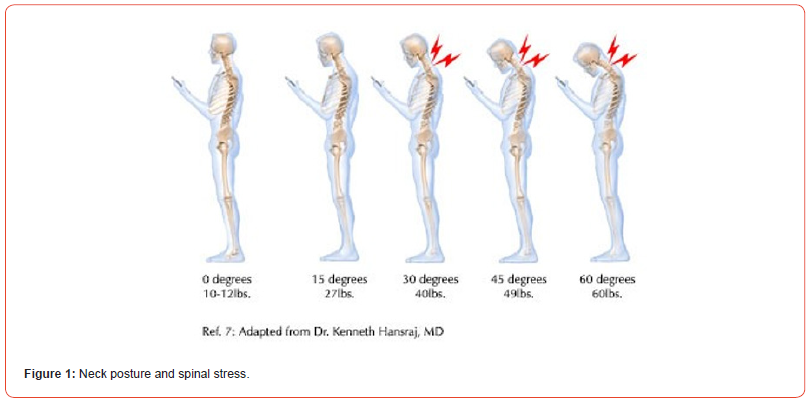
• Does my stool help me work with a neutral posture? If you sit for procedures, the selection of the right ergonomic stool is very important for neutral lower back posture support.
Three Essential Ergonomic Factors When Purchasing Loupes
Working Distance
Working distance is defined as the distance from the eyes to the work area [6, 7]. The most common problem that Dr. Bethany Valachi encounters with her clients is that the distance is often measured too short, which results in excessive neck flexion or hunching [8]. Working distance should be tailored to the individual, for example, the working distance for a shorter clinician will be smaller when compared to the working distance of a very tall clinician. On average, we have found that someone who is 5′ 1″ will have a working distance of 15″, someone who is 5′ 8″ will have a working distance of 18″, and someone who is 6′ 1″ will have a working distance of 20″. A discrepancy of just a few inches can have a significant impact on your comfort and health.
Declination Angle
Declination angle is the angle that your eyes are inclined downward toward the working area. This angle should be steep enough to help you attain a comfortable working position with a minimal forward head posture of 20-degrees or less. The farther the head is positioned forward to see through the loupes, the greater the strain on the neck muscles and discs [6, 9, 10]. The predominant problem that Dr. Valachi encounters regarding declination angles is insufficient, small angles that force the operator to assume an unhealthy working posture [6].
To avoid this insufficient declination angle, have your local representative take a side view photo of you while you are looking at the operating site through the demo loupe when you are ordering your new loupes. You want to see yourself with a more upright posture, looking downward at a steeper angle. Even though declination angle is one of the three essential ergonomic factors when purchasing loupes, most clinicians do not know how to correctly measure it. This allows many companies to incorrectly measure the declination angle by using the angle between the axis of loupes and the temple arms. However, the true declination angle is measured between the axis of the loupes and a line connecting the top of the ear and the corner of the user’s eyes. Therefore, without a user, the true declination angle cannot be determined. Figure 2 shows how some companies use a temple arm reference line to overinflate their achieved declination angle.
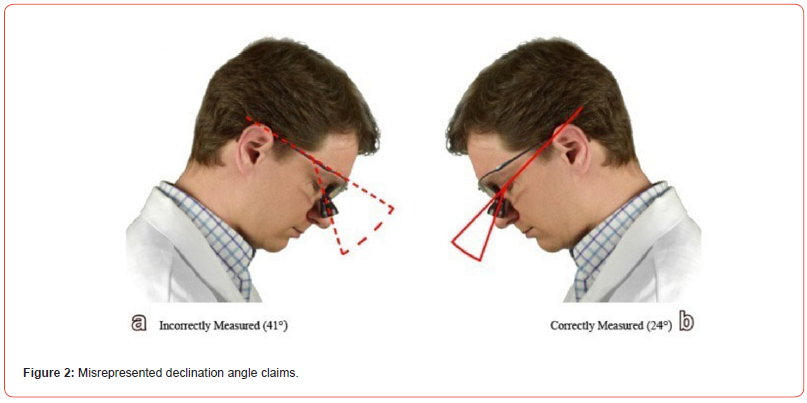
Frame Size/Shape
The lower that a manufacturer can place the ocular in relation to your pupil, the better the declination angle they can generally provide for you [6, 8]. Note: SurgiTel has patented suspended magnification technology which secures the magnification oculars at the very bottom of a sweep or open lens type. This, along with the pantoscopic tilt of our lenses allows us to achieve a steeper declination angle than any other company.
The Difference Between Hybrid Loupe, Deflection Loupe and Straight TTL
Deflection Loupes
The results from the former described procedure revealed only seven guideline documents meeting the specified criteria. These guidelines originated from diverse geographical regions, comprising two from Australia, three from the United States of America, one from Canada, and one from Europe. In Table 3 we summarize the basic characteristics of the clinical guidelines included in our investigation.

Deflection loupes are highly effective in controlled environments, offering precise magnification and an ideal neck tilt of less than 20-degrees (Figure 3). In an office setting your level of control is greatly reduced due to the unpredictable nature of patients and their varying ability to sit in the ideal viewing position for the clinician.
These loupes can be advantageous for students who are honing their skills, as they can precisely position the typodont for optimal visibility. This controlled setup facilitates a focused and ergonomic working posture for the student, setting them up for a pain-free career.
However, the real challenge arises in the dynamic environment of a clinical practice. Patients, with their diverse physical conditions and constraints, may present difficulties in achieving the ideal viewing angle. In such cases, clinicians often find themselves in situations where they must contort into non-ergonomic working postures to gain a clear view into the patient’s mouth.
The paradox emerges when these clinicians, equipped with ergonomic loupes designed to promote a comfortable and sustainable working posture, find themselves forced into nonergonomic positions. This compromise not only affects the practitioner’s physical well-being but also undermines the very purpose of using ergonomic loupes in the first place.
Straight TTL Loupes
One of the key benefits to the straight TTL is the declination angle that allows for an ergonomic neck tilt of 20-degrees or less (Figure 4). This neck angle minimizes strain on the neck and upper body, promoting a more comfortable and sustainable working posture. This ergonomic advantage is crucial for professionals to have a pain-free and healthy career. Another benefit is coaxial vision, which ensures that the line of sight through the loupes aligns with the optical axis of the lenses. This alignment results in a clear and undistorted view, enhancing the precision and accuracy of the clinician’s work.
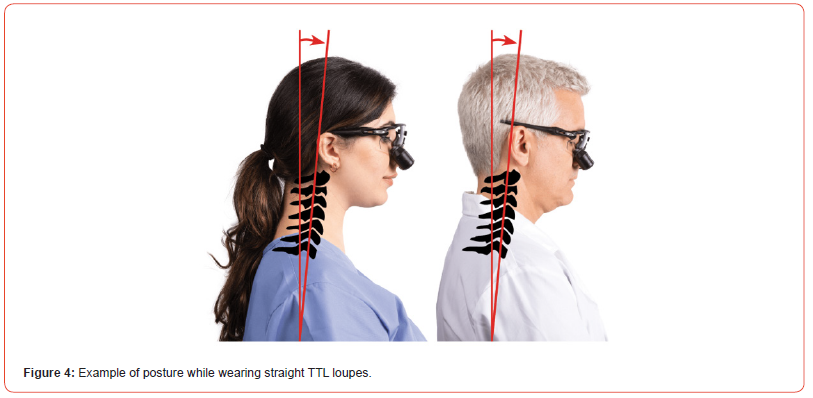
Furthermore, the straight TTL design fosters coaxial vision or natural vision. This allows the magnified vision to be coaxial with peripheral vision. Coaxial vision helps to foster a more natural direct hand-eye coordination and allows clinicians to track where the tools are. This synchronization is instrumental in tasks that require fine motor skills and precision, such as dental procedures.
The compact straight prism design offers a slightly broader field of view and increased depth of field compared to deflection loupes. The magnification options in the prism ocular include 2.5x, 3.0x, 3.5x, 4.5x, 5.5x, 6.5x, 8.0x* and 10.0x* (*only available on Ergo Max 2.0 and Aero frames) providing a versatile range to cater to diverse magnification needs.
Hybrid TTL Loupes
Hybrid TTL loupes are the integration of the advantages offered by both straight TTL loupes and deflection loupes, providing practitioners with a versatile and practical tool for their daily work. The hybrid TTL loupe allows clinicians a great deal of vision over the loupe so they can see their surroundings and the monitor clearly with no interference from the ocular. SurgiTel’s patented suspended magnification and the pantoscopic tilt of our frames play a pivotal role in enhancing the functionality of the hybrid loupes. By utilizing the patented suspended magnification technology, it means that SurgiTel is the only company that is able to produce hybrid loupes.
Benefits of Hybrid TTL (Through The Lens) Loupes
Hybrid loupes combine the advantages of both deflection and straight TTL loupes. One standout feature of hybrid loupes is their steep declination angles, which closely rival those of deflection loupes (Figure 5). The incorporation of SurgiTel’s patented suspended magnification and the pantoscopic tilt of the frames contributes to achieving this notable declination angle. This design innovation allows clinicians to maintain a comfortable and ergonomic head posture, minimizing strain on the neck and upper body during prolonged procedures. The combination of a steep declination angle and ergonomic design ensures that practitioners can work with precision while protecting themselves from pain due to a non-ergonomic posture.
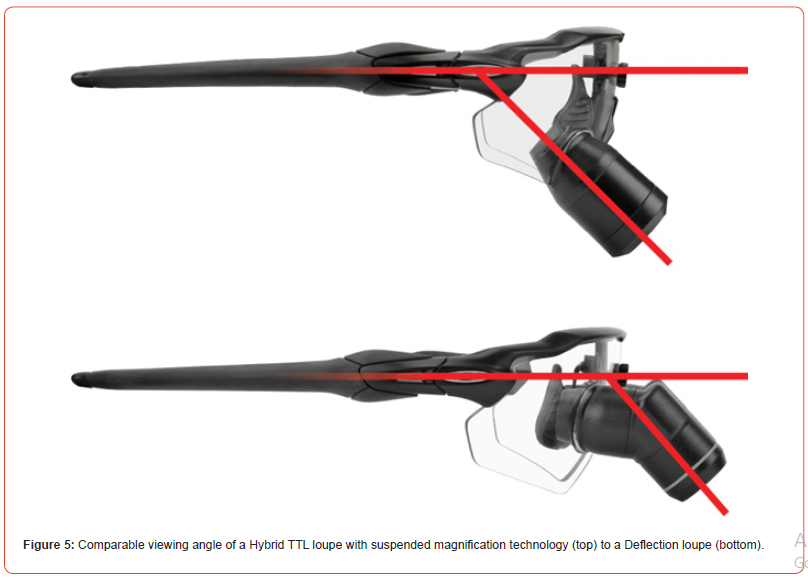
The practicality of hybrid loupes is highlighted by their ability to address real-world clinical challenges. Being able to see if a patient is uncomfortable during a procedure is a crucial aspect of patient care. The hybrid design, like the straight TTL, allows clinicians to maintain good direct vision to their work environment.
Benefits of FLM (Front Lens Mounted) Loupes
SurgiTel’s Front-Lens-Mounted (FLM) loupes (Figure 6) are the only customizable loupes with a full range of magnification powers, allowing customers to create a custom declination angle for their maximum neck comfort. FLM loupes are available either mounted to a frame or headband. FLM loupes and most SurgiTel TTL loupes can deliver any declination angle to support the safe neck posture of less than a 20-degree head/neck tilt. The advantage of straight FLM loupes is that you can incrementally change your declination angle to gradually go from your current posture to a more upright position. After years of working in a bad posture, your spine and body may not be able to go from a hunched-over posture directly to an upright ergonomic posture. If you are a clinician that is operating on patients at different heights, FLM loupes also give you the ability to adjust the vertical direction to align with your operating area. Combining this feature with working distance caps, you can also change the distance that is in focus. With customizable FLM loupes, you can have the most flexibility and customization.
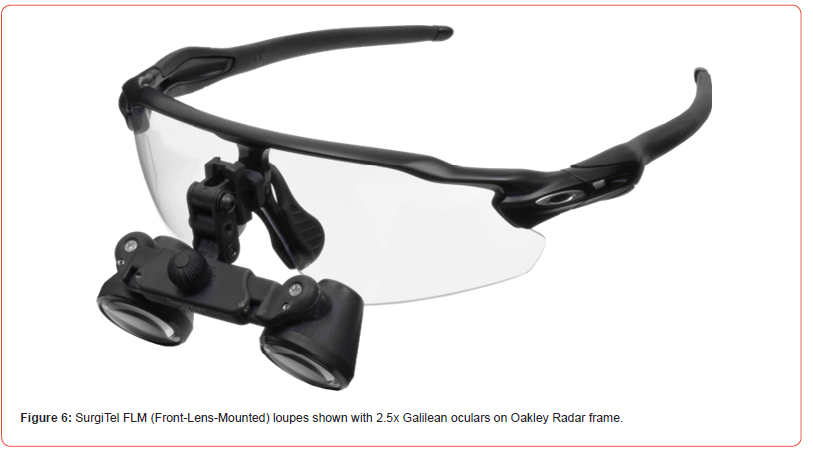
Ergonomic Consultantst
Ergonomic consultants, some of whom are licensed physical
therapists, proactively educate, and objectively evaluate work
environments to identify ergonomic risk factors and expose any
unforeseen workplace hazards [11]. Below is a list of ergonomic
consultants who can analyze and improve your working posture.
Dental
Bethany Valachi - www.posturedontics.com
Ergonomics Dental - https://ergonomicsdental.com/
Surgical
Dr. Geeta Lal - https://surgicalergonomics.com/
Society of Surgical Ergonomics - https://www.
societyofsurgicalergonomics.org/
About SurgiTel
Over the past 30 years, SurgiTel loupe designs have greatly advanced to serve the demands of clinicians. SurgiTel is uniquely situated to provide higher magnification and greater flexibility than competitors. The traditionally designed non-ergonomic loupes are lacking features offered by next-generation SurgiTel patented loupes which allow for a more comfortable weight along with stable, quality vision. SurgiTel has local and international representatives to help clinicians get personalized support.
Acknowledgement
None.
Conflict of Interest
No conflict of interest.
References
- Arnett, Michelle C, Iwonka Eagle (2021) Impact of Loupes and Lights on Visual Acuity and Ergonomics. Dimensions of Dental Hygiene.
- Hayes Melanie J, Peter G Osmotherly, Jane A Taylor, Derek R Smith, Alan Ho (2016) The Effect of Loupes on Neck Pain and Disability among Dental Hygienists. Work (Reading, Mass.) 53(4): 755-762.
- Sunell S, L Rucker (2004) Surgical Magnification in Dental Hygiene Practice. International Journal of Dental Hygiene 2(1) 26-35.
- Branson BG, K K Bray, C Gadbury Amyot, LA Holt, N T Keselyak, et al. (2004) Effect of Magnification Lenses on Student Operator Posture. J Dent Educ 68(3): 384-389.
- Valachi Bethany (2008) Practice Dentistry Pain-Free: Evidence-Based Strategies to Prevent Pain and Extend Your Career. Portland, OR: Posturedontics Press.
- Valachi Bethany (2009) Magnification in Dentistry: How Ergonomic Features Impact Your Health. Dentistry Today.
- Hansraj Kenneth K (2014) Assessment of Stresses in the Cervical Spine Caused by Posture and Position of the Head. Surg Technol Int 25: 277-279.
- Valachi Bethany (2008) Neck Health: The Three Ergonomic Criteria for Loupes Selection. Dental Economics. Endeavor Business Media.
- Cailliet Rene (1991) Neck and Arm Pain, (3rd), 74-75. Philadelphia, PA: F A Davis Co.
- Rucker Lance M, Craig Beattie, Cathy McGregor, Susanne Sunell, Yutaka Ito (1999) Declination Angle and Its Role in Selecting Surgical Telescopes. J Am Dent Assoc 130(7): 1096-1100.
- Koziol Keri (2020) Role of the Ergonomic Consultant. The Beacon Mutual Insurance Co, USA.
-
B Jin Chang*. Ergonomic Loupes: the Essential Tool for Precision and Comfort in Medical Procedures. On J Dent & Oral Health. 7(5): 2024. OJDOH.MS.ID.000672.
-
Medical procedures, Dental, Ergonomic loupes, Neck posture, Marketing materials, Clinical practice, Head/neck tilt, FLM loupes, SurgiTel TTL loupes
-

This work is licensed under a Creative Commons Attribution-NonCommercial 4.0 International License.






